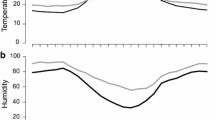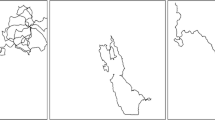Abstract
Grass-cutting ants (Atta vollenweideri) carry leaf fragments several times heavier and longer than the workers themselves over considerable distances back to their nest. Workers transport fragments in an upright, slightly backwards-tilted position. To investigate how they maintain stability and control the carried fragment’s position, we measured head and fragment positions from video recordings. Load-transporting ants often fell over, demonstrating the biomechanical difficulty of this behavior. Long fragments were carried at a significantly steeper angle than short fragments of the same mass. Workers did not hold fragments differently between the mandibles, but performed controlled up and down head movements at the neck joint. By attaching additional mass at the fragment’s tip to load-carrying ants, we demonstrated that they are able to adjust the fragment angle. When we forced ants to transport loads across inclines, workers walking uphill carried fragments at a significantly steeper angle, and downhill at a shallower angle than ants walking horizontally. However, we observed similar head movements in unladen workers, indicating a generalized reaction to slopes that may have other functions in addition to maintaining stability. Our results underline the importance of proximate, biomechanical factors for the understanding of the foraging process in leaf-cutting ants.






Similar content being viewed by others
References
Abdel-Aziz YI, Karara HM (1971) Direct linear transformation from comparator coordinates into object-space coordinates in close-range photogrammetry. Proceedings of ASP symposium on close range photogrammetry. Urbana Illinois, USA, pp 1–18
Bässler U (1977) Sense organs in the femur of the stick insect and their relevance to the control of position of the femur-tibia-joint. J Comp Physiol A Neuroethol Sens Neural Behav Physiol 121:99–113
Burd M (1996) Foraging performance by Atta colombica, a leaf-cutting ant. Am Nat 148:597–612
Burd M (2000a) Body size effects on locomotion and load carriage in the highly polymorhpic leaf-cutting ants Atta colombica and Atta cephalotes. Behav Ecol 11:125–131
Burd M (2000b) Foraging behaviour of Atta cephalotes (leaf-cutting ants): an examination of two predictions for load selection. Anim Behav 60:781–788
Burd M (2001) Leaf tissue transport as a function of loading ratio in the leaf-cutting ant Atta cephalotes. Ecol Entomol 26:551–556
Duysens J, Clarac F, Cruse H (2000) Load-regulating mechanisms in gait and posture: comparative aspects. Physiol Rev 80:83–133
Fowler HG, Forti LC, Pereira-da-Silva V, Saes NB (1986) Economics of grass-cutting ants. In: Lofgren CS, Vander Meer RK (eds) Fire ants and leaf cutting ants—biology and management. Westerview Press, Boulder, pp 18–35
Hölldobler B, Wilson EO (1990) The ants. Harvard University Press, Cambridge
Jonkman JCM (1976) Biology and ecology of the leaf-cutting ant Atta vollenweideri. Z Angew Entomol 81:140–148
Jonkman JCM (1980) Average vegetative requirement, colony size and estimated impact of Atta vollenweideri on cattle raising in Paraguay. Z Angew Entomol 89:135–143
Lewis OT, Martin M, Czaczkes TJ (2008) Effects of trail gradient on leaf tissue transport and load size selection in leaf-cutter ants. Behav Ecol 19:805–809
Lighton JRB, Bartholomew GA, Feener DH Jr (1987) Energetics of locomotion and load carriage and a model of the energy cost of foraging in the leaf-cutting ant Atta columbica Guer. Physiol Zool 60:524–537
Lutz FE (1929) Observations on leaf-cutting ants. Am Mus Novit 388:1–21
Markl H (1962) Borstenfelder an den Gelenken als Schweresinnesorgane bei Ameisen und anderen Hymenopteren. Z vergl Physiol 45:475–569
Roces F (1990) Leaf-cutting ants cut fragment sizes in relation to the distance from the nest. Anim Behav 40:1181–1183
Roces F, Bollazzi M (2009) Information transfer and the organization of foraging in grass- and leaf-cutting ants. In: Jarau S, Hrncir M (eds) Food exploitation by social insects: ecological, behavioral, and theoretical approaches. Contemporary topics in entomology series. CRC Press, Boca Raton, pp 261–275
Roces F, Lighton JRB (1995) Larger bites of leaf-cutting ants. Nature 373:392–393
Roces F, Núñez JA (1993) Information about food quality influences load-size selection in recruited leaf-cutting ants. Anim Behav 45:135–143
Röschard J, Roces F (2002) The effect of load length, width and mass on transport rate in the grass-cutting ant Atta vollenweideri. Oecologia 131:319–324
Röschard J, Roces F (2003a) Cutters, carriers and transport chains: distance-dependent foraging strategies in the grass-cutting ant Atta vollenweideri. Insect Soc 50:237–244
Röschard J, Roces F (2003b) Fragment-size determination and size-matching in the grass-cutting ant Atta vollenweideri depend on the distance from the nest. J Trop Ecol 19:647–653
Rudolph SG, Loudon C (1986) Load size selection by foraging leaf-cutter ants (Atta cephalotes). Ecol Entomol 11:401–410
Schmitz J (1993) Load-compensating reactions in the proximal leg joints of stick insects during standing and walking. J Exp Biol 183:15–33
Ting LH, Blickhan R, Full RJ (1994) Dynamic and static stability in hexapedal runners. J Exp Biol 197:251–269
Weihmann T, Blickhan R (2009) Comparing inclined locomotion in a ground-living and a climbing ant species: sagittal plane kinematics. J Comp Physiol A Neuroethol Sens Neural Behav Physiol 195:1011–1020
Wetterer JK (1990) Load-size determination in the leaf-cutting ant, Atta cephalotes. Behav Ecol 11:95–101
Zill S, Schmitz J, Büschges A (2004) Load sensing and control of posture and locomotion. Arth Struct Dev 33:273–286
Zollikofer CPE (1994) Stepping patterns in ants. 3. Influence of load. J Exp Biol 192:119–127
Acknowledgments
This study was funded by a Dissertation Grant from the UK Biotechnology and Biological Sciences Research Council, by the German Academic Exchange Service (DAAD), by the Cambridge European Trust, by the Balfour Fund of the Department of Zoology (University of Cambridge), and by the German Research Foundation (DFG, Sonderforschungsbereich SFB 554/TPE1). We thank Martin Bollazzi for helpful discussions and Thomas Endlein for technical support. We are much indebted to Alejandro G. Di Giacomo and the Götz family for allowing the collection of the ant colony at the Reserva Ecológica El Bagual (Alparamis SA - Aves Argentinas) in Eastern Chaco, Province of Formosa, Argentina.
Author information
Authors and Affiliations
Corresponding author
Appendix
Appendix
We used simplified two-dimensional models to calculate the fragment angle that a load-carrying ant should keep to avoid any forward or backward shift of the total center of mass (Figs. 7, 8).
Calculation of the angle α‘ at which the ants would have to hold long fragments to keep the projected position of the total center of mass constant. α Fragment angle for short fragments, l f length of short fragment, l′f length of long fragment, COM a: ant center of mass, COM f fragment center of mass, COM t total center of mass, c f (c t) distance between mandibles and the projection of COMf (COMt)
Calculation of the fragment angle α′ required to keep the distance c t between the mandibles and the total center of mass (projected onto the body axis) constant when walking on slopes: a uphill (ω = 20°), b horizontal and c downhill (ω = −20°). α Fragment angle when walking horizontally, c f distance between the mandibles and the projected fragment center of mass, l f length of the fragment, COM a ant center of mass, COM f fragment center of mass, COM t total center of mass
Fragments of different length
When carrying short and long fragments, ants have to change the fragment angle to avoid any forward or backward shift of the total center of mass (COMt, ant + fragment). Thus, the anterior–posterior position of the center of mass (i.e. the vertical projection of COMt onto the body axis) has to remain unchanged. This implies that
where c t is the distance between the mandibles and the total center of mass (both projected onto the body axis, see Fig. 7) for the short fragment, and c t ’ the corresponding distance for the long fragment. As the fragment mass and the ant’s body mass are the same in both cases, the projected position of the fragment’s center of mass along the body axis remains also constant:
where c f is the projected distance between the mandibles and the fragment center of mass. As the ants hold the fragment very near the end, c f can be expressed in terms of the fragment’s length l f and angle α for short fragments
and accordingly for long fragments:
Combination of Eqs. 3, 4 and 5 gives a prediction for the fragment angle when carrying long fragments:
As the mean angle for short fragments (l f = 15 mm) was α = 39°, we would therefore expect ants to carry long fragments (\( l'_{\text{f}} \)=30 mm) at an angle of α′=67° to keep the projected position of the total center of mass constant.
Carrying fragments on slopes
As for fragments of different length, ants carrying the same fragment on different slopes should adjust the fragment angle to keep the distance between the mandibles and the projected total center of mass constant (see Eq. 2). We use the projection of COMt onto the body axis here; the small distance between the body and the surface is ignored here for simplicity. To predict the angle α′ at which ants would have to carry fragments on different slopes ω to avoid any forward or backward shift of COMt, we used a similar model as above (Fig. 8). As both the ant’s mass and the fragment mass do not change when walking on slopes, Eq. 3 is valid. For an ant carrying a fragment horizontally the distance between the mandibles and the projected fragment center of mass is given by Eq. 4. The corresponding distance for ants walking uphill and downhill is
Combination of Eqs. 3, 4 and 7 gives the prediction for the fragment angle required to keep the distance between the mandibles and the projected total center of mass constant:
Ants carrying the fragment at an angle of α = 45° when walking horizontally, should hold it at α′=68° when walking uphill (ω = +20°) to keep c t constant. Correspondingly, when walking downhill (ω = −20°), they should carry the fragment at an angle of α′=28°. Equation 8 shows that ants walking uphill would have to hold fragments in a forward orientation (α′ > 90°) already for slopes of ω > arctan(cosα) = 35.3° (for α = 45°). For even steeper slopes, the contribution of the small distance between body and substrate will become important, making it increasingly difficult even for unloaded ants to keep their center of mass within the supporting leg tripod.
Rights and permissions
About this article
Cite this article
Moll, K., Roces, F. & Federle, W. Foraging grass-cutting ants (Atta vollenweideri) maintain stability by balancing their loads with controlled head movements. J Comp Physiol A 196, 471–480 (2010). https://doi.org/10.1007/s00359-010-0535-3
Received:
Revised:
Accepted:
Published:
Issue Date:
DOI: https://doi.org/10.1007/s00359-010-0535-3






